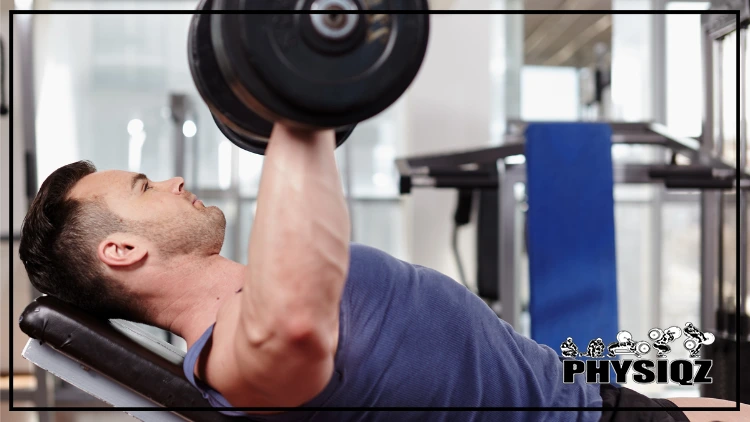
A push day workout regimen is an effective way to develop upper body strength in the chest, shoulders triceps and is the counterpart to pull days in programs that separate days by push, pull and occasionally legs.1
The 7 exercises in this program were chosen due to their effectiveness proven by actual studies and they’re also ranked so you have an idea of which ones offer the most bang for your theoretical buck.
What Are the Push Muscles or Push Muscles Worked?
The push muscle groups, as the name suggests, are responsible for the pushing movement pattern generated by the human body—the main muscles that are responsible for pushing are the pecs (chest), anterior (front) and lateral (side) deltoids which are part of the shoulders muscles and triceps located at the back of the upper arm.
- Pecs—The chest muscles are the primary pushers in upper body pushing workouts, being heavily engaged in exercises like the bench press and push ups.
- Triceps—Triceps work to extend the arms at the elbow joint to complete the pushing of the load once the pecs have moved the load away from the torso.
- Shoulders—Shoulders are significantly involved as pressing muscles in the overhead press, bench press and isolation movements that target them.
What Is a Push Day When It Comes To Working Out?
A push-focused training session, as can be inferred, is a workout day that has the lifter focus on the pushing muscles, which are the chest, shoulders, and triceps. This workout day also targets other smaller muscle groups that help in the pushing movement, such as the forearms and abdominals.
The push day workout is one of the three workouts that is in a PPL routine; the PPL being an acronym for workout routines split into:
- Push day
- Pull day
- Leg day
Upper body training sessions are generally done 1-2 times a week, but this will also typically depend on the goals and time constraints of the lifter. The workouts will include a mix of compound (exercises that hit multiple muscle groups in one go) and isolation (exercises that target one specific muscle) movements.
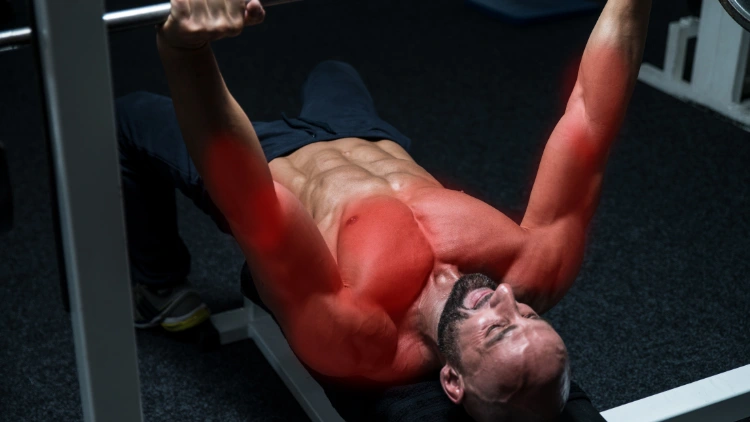
Source: Ibrakovic via Canva.com2
The workout focusing on pushing movements also differs from the full body workout where both upper and lower body muscles are trained in one session. PPL routines are popular in bodybuilding because they are effective if done correctly—contributing to superior hypertrophy (muscle) and recovery.
How Are Push Days Programmed? What Is the Ideal Format for a Push Day?
Push days which are integrated into an overall PPL routine, can be alternated over three days in a week where each routine would have its own day; say Monday, Wednesday and Friday with rest days in between. This however is not ideal because it will mean that a body part receives training only once a week.
For effective hypertrophy, muscles must receive training stimulus at least 2 times a week or even 3 times a week.3
It is usually better practice to start with heavier lifts at the beginning of a workout schedule and it is not necessary to have a rest day between push and pull workouts since they engage different muscle groups. Some lifters choose to combine leg and core workouts in one day.
A few sample formats can be seen below:
6 Day Push Pull Legs Example Routine
| Day | Exercise |
| Monday | Push day |
| Tuesday | Pull day |
| Wednesday | Legs and core day |
| Thursday | Push day |
| Friday | Pull day |
| Saturday | Legs and core day |
| Sunday | Rest |
5 Day Push Pull Legs Example Workout
The 5-day push-pull workout will have both workout routines spread over 6 days and have the lifter dedicate one day to cardio, one to legs, and take one day off. A sample of the regimen appears below. This program is ideal for those who already have experience in the gym.
| Day | Workout Day |
| Monday | Push day (chest, shoulders, triceps) |
| Tuesday | Pull day (back, biceps) |
| Wednesday | Leg day (quads, hamstrings, glutes, calves) |
| Thursday | Off |
| Friday | Push day (chest, shoulders, triceps) |
| Saturday | Pull day (back, biceps) |
| Sunday | Cardio |
4 Day Push Pull Workout Routine
The 4 day push pull workout routine is a compacted routine that consists of two push days and two pull days. An example of a 4 day push pull routine appears below and is suited for beginners who are just getting their feet wet into the weightlifting world or those that are short on time.
| Day | Workout Day |
| Monday | Push day (chest, shoulders, triceps) |
| Tuesday | Pull day (back, biceps) |
| Wednesday | Off |
| Thursday | Push day (chest, shoulders, triceps) |
| Friday | Pull day (back, biceps) |
| Saturday | Off |
| Sunday | Off |
7 Exercises for Push Days To Use On Push Days: Ranked Worst to Best (Push Workout Routine)
This push day workout regimen consists of 7 exercises that are a mix of compound movements with two isolation movements. These workouts are ranked from worst to best and are backed by studies to show their effectiveness and efficiency to pack on muscle and build strength by hitting all muscles heads and meeting volume landmarks—these include pushups, barbell bench press and incline dumbbell press.
7. Pushups
Push ups are an old school and classic exercise that should be a staple of any lifter’s regimen from beginners to advanced lifters. They target mainly the pecs, shoulders and triceps muscles.
In addition to these muscles, push ups also engage the abdominals, legs and hips.
Push ups are considered a benchmark for gauging upper body strength often in the military as well, which is a testament to their effectiveness.
They can be used either as a warm up to a push day or be used to finish off the day to get those chest muscles infused with blood. They are very versatile not only because they can be done anywhere due to using only body weight, but can be modified by adjusting the speed, hand placement and angle of the torso to increase intensity and target specific muscles.4
While push-ups are a pushing exercise, pull ups are a pulling exercise that can in be included in a pull day workout after a push day and since there is no difference between a pull up vs push up workout in that they both employ body weight, they complement each other well and can both be done at home.
How To Perform Push Ups:
- Lifters should assume a plank position with feet together, torso straight and rigid and hands slightly wider than the shoulders.
- Elbows should be tucked towards the body and head, remaining neutral. Movement is initiated by lowering the torso until the chest is almost touching the floor.
- Pause and press back up to the starting position and complete desired reps.
Cues When Performing Push Ups:
- Knees and hips should always remain locked in and elbows tucked towards the body.
- Advanced lifters who end up doing many pushups can apply negative tempos by slowing their descent counting 5-10 seconds before chest touches the floor before explosively pressing up. This will increase the intensity and make them more challenging.
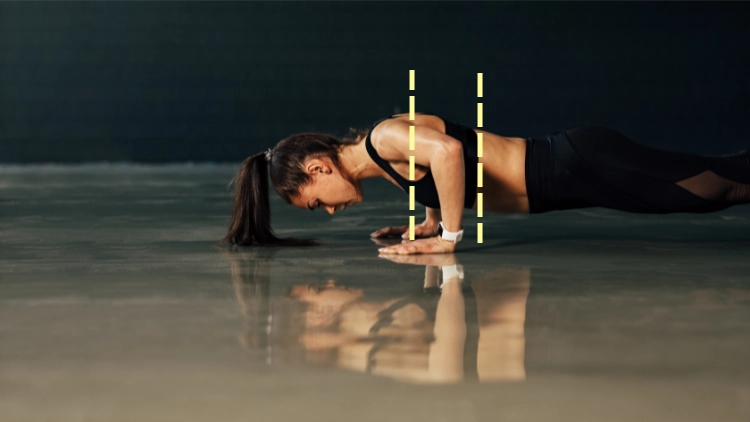
Source: Artem Varnitsin via Canva.com5
6. Overhead Cable Triceps Extension
Overhead cable triceps extensions employ the use of a machine to engage the triceps and they do seem like a pulling exercise at first glance, but are a pushing exercise that helps ensure stability to the upper back and rear delts. The cables guarantee that there is constant tension on the triceps throughout the ROM which is excellent for muscle growth.
They are similar to the cable triceps pushdown but are performed overhead—because of this overhead position, there is a substantially greater triceps hypertrophy versus when the arm is neutral.6 Overhead cable triceps extensions are very versatile with a number of variations such as cable press downs and cable lying triceps extensions, and can be done while sitting or standing.
How To Perform Overhead Cable Triceps Extension:
- While sitting on a bench, with feet flat and facing away from the bench, grab the ends of the rope attachment.
- The lifter should position themselves such that the elbows are overhead and hands behind traps holding onto the rope.
- Contract the triceps and extend hands until they are directly overhead. There should be a focus on keeping arms vertical.
- Pause for a brief moment, and slowly reverse the movement back to the starting position.
Cues When Performing Overhead Cable Triceps Extension:
Upper arm should always be positioned and set such that the elbows are pointing up.
5. Dumbbell Lateral Raises
Many gym goers have always mistaken dumbbell lateral raises as a pulling exercise, but they are a pushing exercise as they make use of the shoulder muscles which are pushing muscles. The lateral raise is an exercise that places focus on the lateral (side) delts which don’t receive enough activation in shoulder pushing exercises such as the barbell press.7
They also work the front delts and traps muscles which help stabilize the joint.
If a lifter wants well defined and sculpted shoulders that are rounded, then the lateral raise foots the bill. Moreover, they help enhance shoulder mobility, stability and range of motion which carries over to other lifts and presses.
How To Perform Dumbbell Lateral Raises:
- To set up, the lifter should stand tall with feet hip-width apart and position the arms at sides while holding a dumbbell in each hand.
- Initiate the movement by raising the arms to the sides until they are at the same level as the shoulders. Ensure that the palms are facing downward.
- Pause for a brief movement before lowering the weight back to the starting position; repeat for desired reps.
Cues When Performing Dumbbell Lateral Raises:
- Lifters must do their absolute best not to heave and throw the upper body in a bid to get momentum, particularly as they tire when reaching technical failure. Dumbbell lateral raises must be done with controlled movements to effectively engage the side delts—the shoulder alone must work to move the weights and not receive help from either the torso or other muscles.
- To engage the side delts even more, they can be done with a slight lean when standing.
- Elbows should always stay above the wrists.
- Dumbbells should not touch the body nor hang at the bottom end of the movement as this will take away tension from the side delts.
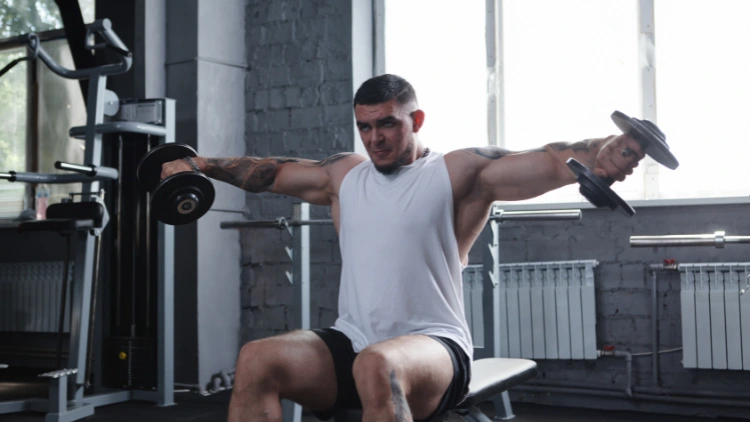
Source: madproduction via Canva.com8
4. Close Grip Bench Press
The close grip bench press is a variant of the traditional barbell bench press and can also be done with dumbbells; it differs from its sibling in that the lifters assume a narrower grip width. Because of a narrower grip width, the triceps muscles are brought into focus more so than the other primary movers, the pecs and the shoulders.9
An added bonus of doing the close grips bench press as per a 1995 study shows this type of movement increased activation in the clavicular head of the pectoralis major—these are the upper pec muscles.10 The close grip bench generally works the triceps, upper and lower pecs and shoulder muscles.
How To Perform Close Grip Bench Press:
- Lifters should lay flat on a bench with feet firmly planted and grip the barbell with hands slightly narrower than shoulder width and never too close together.
- Unrack the bar and pull it such that it is directly over the shoulder joint when the arms are extended.
- Initiate the movement by slowly lowering the bar pulling it to the ribcage and land consistently at the bottom of the pecs.
- Press the bar to the starting position and complete for desired reps.
Cues When Performing Close Grip Bench Press:
It is not recommended to have the width with hands touching or being 6 inches from each other, as this may lead to internal rotation of the shoulders which can result in injury. The efficient position is to be between 95%-100% of the biacromial distance (distance between shoulder blades) for the closed grip bench press.11
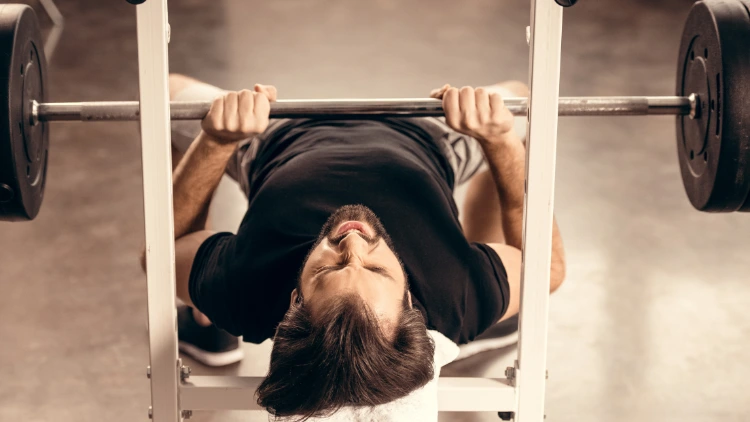
Source: LightFieldStudios via Canva.com12
Due to differing anatomies, experiment which range works best.
3. Standing Overhead Shoulder Barbell Press
The standing overhead shoulder barbell press, also known as the military press, is a comprehensive shoulder exercise that can be used to build and pack shoulder muscle. Its primary muscle of focus is the front deltoids as the primary movers and is superior at activating the primary movers than machine presses—it also works the side and rear delts to a lesser degree.13
The barbell allows the lifter to go heavy on this exercise.
Few movements can match this exeric;es ability to build shoulder muscle and strength making it a must have exercise to be included in the routines of those with bad shoulder genetics such as a shoulder and bicep workout program.
As one of the compound shoulder exercises, the overhead shoulder barbell presses also targets the upper pecs, triceps and engages the core due to the need to stabilize the spine. Standing overhead shoulder barbell press are a versatile exercise and has a number of variations which can be included in other push days and these are:
- Seated military press
- Arnold press
- Seated dumbbell press
- Smith machine military press
- Behind the neck military press
How To Perform Standing Overhead Shoulder Barbell Press:
- To set up, the lifter should adjust the barbell such that it is below shoulder height and load the desired weight.
- They should then assume a stance that is shoulder width and grip the bar slightly outside of shoulder width using pronated (overhand) grip.
- Unrack the bar making sure to keep the spine in a neutral position.
- Once stepped back, brace the core, inhale and proceed to press the bar to lockout.
- Exhale and reverse the movement slowly lowering the bar with control to the chest.
- Repeat for desired reps.
Cues When Performing Standing Overhead Shoulder Barbell Press:
- Do not lean back at the top of the movement and turn into a standing bench. As the bar is pressed up and clears the head, push the head through the hole created by the arms and the barbell.
- Make sure to always use correct form by using weight that can be handled.
- Do not flare the elbows, rather keep them tucked in.
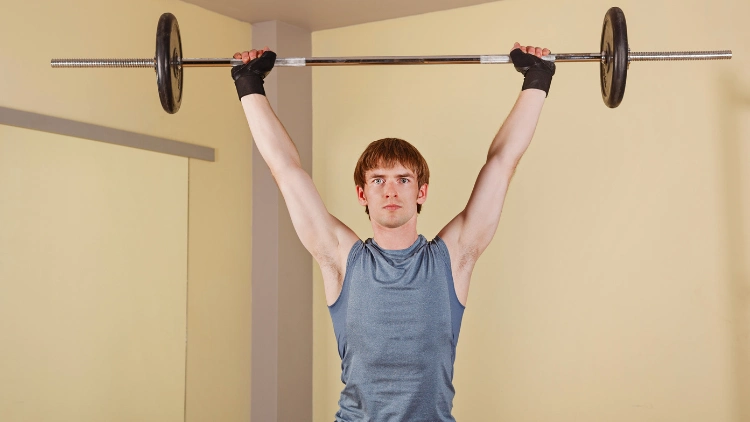
Source: elenavagengeim via Canva.com14
2. Barbell Bench Press
The bench press is easily one of the most robust pushing exercises that is available to the lifter and builds the upper body like no other while helping lifters at getting stronger. It is a staple that has been used since the early days of bodybuilding, and is easily a classic that allows the maximum load to be moved in a pushing exercise.
It can also be done with dumbbells and has a number of variations that can be included in a push day:
- Incline barbell bench press
- Decline barbell bench press
- Paused bench press
- Negative bench press
- Partial bench press
Since it is possible to go heavy on the barbell bench press, this exercise builds massive pecs, shoulders and triceps that contribute to the lifter’s v-taper look while also strengthening the muscles of the upper back.15 It is a functional exercise that carries over to daily activities such as carrying and pushing.
The barbell bench press is a core and important exercise in many workout programs for beginners, bodybuilders and powerlifters alike such as such as:
- Starting strength routine
- Ice cream fitness 5×5 workout program (ICF by Jason Blaha)
- Greyskull LP: Powerbuilding program for beginners
- Six day workout routine plan
- Eight week powerlifting program
- Nsuns 531 Cap3
- Bench press pyramid
How To Perform Barbell Bench Press:
- To set up, lay on a bench with feet firmly planted on the ground.
- The lifter should then proceed to grip the bar with hands shoulder width apart.
- Unrack the barbell and set it so that it is directly over the shoulder joint when the arms are extended.
- Lower the barbell in a controlled manner and let it rest slightly below the pecs and nipples.
- Press the bar upwards back to the starting position and complete desired reps.
Cues When Performing Barbell Bench Press:
- The bench press is a pushing movement. However, lifters should also view it as a pulling movement and should think of pulling the bar back into the chest rather than letting the bar lower itself. By doing it this way, the muscles will constantly be engaged and under tension, for a much better and powerful press.
- Always keep the wrist joint stacked above the elbow joint for efficient pressing
- Don’t flare the elbows and keep them tucked, but not overly tucked and close to the torso.
- The bar should always touch at the same point and not be bounced back up.
- To maintain constant tension in the triceps, avoid completely locking out the elbows.
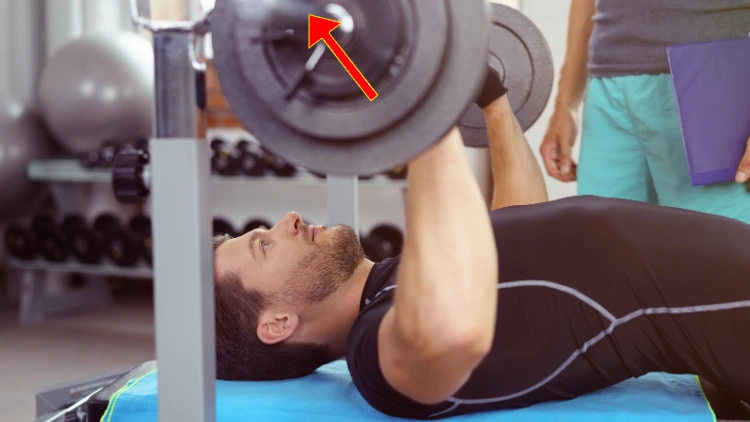
Source: stockfour via Canva.com16
1. Incline Dumbbell Press
The incline dumbbell press takes the top spot for pushing exercises because it employs the use of dumbbells. While barbells allow for a heavier lift resulting in a raw stimulus magnitude, dumbbells allow the lifter to put the load through a much longer ROM since there is no barbell to inhibit the arms from descending lower.
This allows the pecs to go into a deeper stretch which is an advantage for hypertrophy. The dumbbell press has been shown in studies to activate the pecs and the biceps much more than the barbell due to the increased ROM and weighted stretch experienced.17
In addition, dumbbells do not have a restrictive ROM that a barbell produces and as a result, lifters are less prone to injury and can effectively use the exercise to build big sculpted chest muscles. They also provide a unilateral aspect to the exercise allowing each side to lift its own weight helping address muscle imbalances.
It is no wonder that the incline dumbbell press finds itself in popular training programs such as the phul hypertrophy training and 5 day powerbuilding split. The incline dumbbell press can also be done on a flat bench as its barbell counterpart.
How To Perform Incline Dumbbell Press:
- Grab a pair of dumbbells and lay on an incline bench that is set at 45 degrees keeping the weights close to the chest.
- Maintain tension in the upper back, inhale deeply and press the dumbbells to lockout.
- Lower the weight in a slow controlled manner and low as is comfortable but aim to have the handles being about chest level.
- Contract the chest and press the dumbbells back to the starting position and complete desired reps.
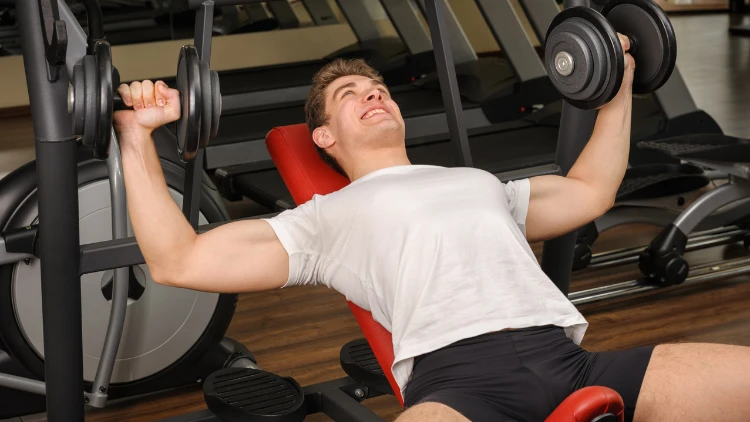
Source: starush via Canva.com18
Cues When Performing Incline Dumbbell Press:
- It’s easy for the arms to get off track and bar path due to holding independent dumbbells, therefore lifters should pay mind to imagining having the same path when they hold a barbell.
- Ensure shoulder blades are slightly retracted especially if shoulder pain creeps in.
- Squeeze the dumbbells tightly to promote shoulder stability.
- Weights should be tilted at 45 degrees to allow the elbows to remain neutral.
- Imagine pushing away from the weights rather than pushing the weights away.
Benefits of a Push Days
The push day workout is an integral part of the lifter’s routine serving to build a solid foundation for upper body strength and mass and confers other benefits as well, such as bringing efficiency to the training since it splits it up and is easy to remember and follow.
Allows for Efficient Training & Splitting of Workouts for Optimal Recovery
Incorporating a PPL program is an efficient and effective way of training the body as lifters often have a push day, pull day and then leg sequence of workouts. This simple way of working out means one segment of the body can be focused on in a single session, and then it is allowed to rest and recover while the other segments are being trained in subsequent workouts.
This often results in PPL muscles being worked out twice which is great for hypertrophy and it means that a lifter trains 6 days, but allows each segment to have 5 days off the week for rest while other parts are being trained.
Easy To Remember & Follow
It is easy for someone to recognize whether an exercise is a push or pull exercise just by simply looking at the mechanics. This makes it easy for even a beginner to identify a number of push exercises and complete a couple of sets in the 8-12 rep range and still get an effective workout without complications.
Lifters of all experience levels can easily put together their own customizable push days.
It Is Flexible To Accommodate Multiple Training Goals
The flexibility of this format of working out means it can easily be applicable to different training goals such as building muscle, getting stronger, leading a healthier lifestyle or losing weight.
- Those focused on training for strength can effortlessly do so in a push day by pushing their strength limits in compound movements such as the bench press in an attempt to smash their PR’s.
- Upper body training sessions are great for hypertrophy, allowing muscles to be hit twice a week which subsequently increases metabolism and burns calories.The workout that centers on pushing exercises also differs from the full body workout where both upper and lower body muscles are trained in one session.19
- Lifters looking to pack on muscle mass can easily program a PPL workout to effectively build muscles in their pecs, shoulders and triceps. Individuals are also able to easily keep track of their progress of reps and weight loads.
Allows Multiple Important Muscles Groups To Be Covered
The workouts focused on pushing involve one movement and that is pushing load. However, this one movement type allows a lifter to cover 3 important muscle groups that make up a significant part of the body and physique.
A well completed push day allows the lifter to cross off working key muscle groups in one single day.
Push Workout Routine Programs: Best Push Day Routine
There are a number of push pull legs routine PPL routine programs that are available to lifters to suit their different training goals and their level of advancement in training, whether beginners or advanced.
The 5-day push-pull workout and 4-day push-pull workout routine samples below include both push and pull days, and there is a push-day routine that is tailored for lifters looking to increase their strength and one for those who are looking to increase hypertrophy rates.
Push Day Workout Regimen for Strength
This is a sample push day that is done for strength and is similar to the Coolcicada PPL push pull legs routine Bodybuilding forum vs reddit PPL routine that was famously made by Reddit user Coolcicada. The routine garnered popularity on the social media platform, a testament to the effectiveness of PPL programs generally.
Some exercises on this routine are done as a percentage of the 1RM—the exercises should be done in descending order with pushups finishing off the routine. The exercises are done with a low repetition scheme while those done for muscle growth below have a higher rep count.
Studies have concluded that when resistance training is performed with strength goals, heavy loads at 80%-100% of 1RM should be used for 1-5 reps; while programs that call for moderate loads at 60%-80% of 1RM and done in the 8-12 rep range are ideal for hypertrophy.20
| Exercise | Sets X Reps |
| Barbell bench press | 5 x 5 @ 80% of 1RM |
| Paused bench press | 5 X 3 (2 seconds for the pause) @ 75% of 1RM |
| Close grip bench press | 4 x 6 @ 65% of 1RM |
| Overhead cable triceps extension | 4 X 12 |
| Pushups | 3 X (As many reps as possible) |
Push Day Routine for Muscle Growth
This routine is for muscle growth and has the lifter do more reps per set which is a stimulus for muscle growth as aforementioned. These exercises should also be done in descending order.
| Exercise | Sets X Reps |
| Barbell bench press | 4 x 10 @ 65% of 1RM |
| Negative bench press | 5 x 4 (tempo should be 5 seconds) @ 60% of 1RM |
| Standing overhead shoulder press | 3 x 10 |
| Dumbbell lateral raise | 3 x 10 |
| Cable rope pushdowns | 3 x 10 |
| Overhead cable triceps extension | 3 x 10 |
At Home Push Day Workout Program
For lifters who don’t have access to a gym or those who may be traveling but still want to keep up with their programs, the following routine can be used that uses body weight as resistance. These should also be done in descending order.
| Exercise | Sets X Reps |
| Handstand push-ups against a wall | 4 x 5 |
| Backpack front raises | 4 x 12 (lifter should hold the strap of backpack in front of them) |
| Milk jug lateral raises | 4 x 10 (a full gallon jug should be held in each hand) |
| Push-ups | 4 x (As many reps as possible) |
Cues for Getting the Most of out a Push Day
It is clear that the push day workout and the overall PPL routine can help lifters achieve their goals in a simple and efficient manner, but there are some cues that lifters should follow to allow the program to reach its full potential. These include using proper form, using full ROM and following principles such as progressive overload and periodization.
Proper Form
Lifters need to maintain good form when involved in upper body workouts to result in proper engagement of the target muscles and also to make sure that other muscles are not brought on to assist the target muscles. Typically, proper form is compromised when lifters are engaged in ego lifting and lifting heavier weights than the muscle can handle.
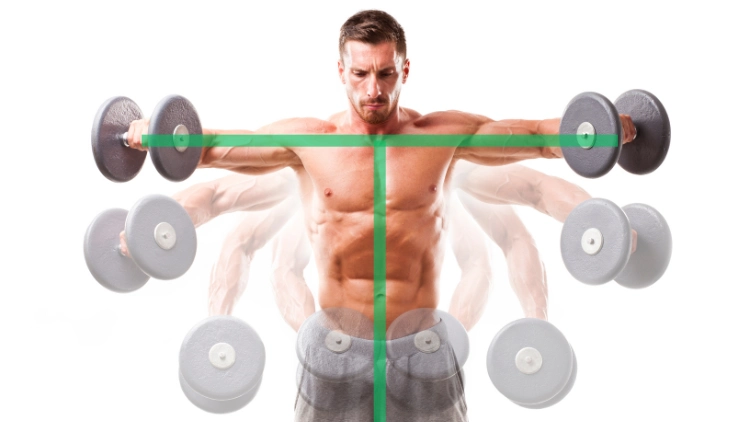
Source: mihailomilovanovic via Canva.com21
Use weight that can be handled as will this lead to better and faster results and also prevent injury that will prevent return to the gym which can be a pain for many lifters. Use slow controlled movements rather than jerk heavy weight using momentum to help establish a mind muscle connection.
Mind Muscle Connection
Mind muscle connection is the act of paying mind and/or attention to the target muscle as it is being contracted under load. This is an important variable that is often missed by many lifters, and has been used by elite bodybuilders like Arnold Schwarzenegger.
Using weight that the muscle can manage and controlled movements will aid lifters increase the mind muscle connection which has been shown by numerous studies to increase the activation of the target muscle which logically leads to muscle and strength gains.22
Using Full ROM
The ROM is an important variable in strength training and performing strength training exercises with a full range of motion allows the muscle to reach its full potential. This results in a maximal activation that subsequently leads to increased hypertrophy rates.23
For example, exercises like the barbell bench press should have a bench press bar path that has the bar touch a tad below the pecs, for lifters wondering about the bar should touch on the bench press. This allows for the pecs to get a stretch to completely activate the muscle fibers.
Reps in Reserve (RIR)
Lifters should allow for 3-4 reps in reserve on the pushing movements. Reps in reserve is the number of reps that a lifter has remaining in an exercise before reaching technical failure—studies have shown when strength training programs are done this way, that is having 3-4 repetitions in reserve at moderate to high loads, there is a significant increase in muscle growth.24
While it is good to go to failure in strength training every now and then, it should not be done all the time, as it could lead to overtraining and increase the risk for injury.
Pushing exercises should be done at a rating of 7-8 (vigorous activity) on the Borg rating of perceived exertion (RPE)—this rating is essentially a measure and scale of the intensity level of an exercise.25
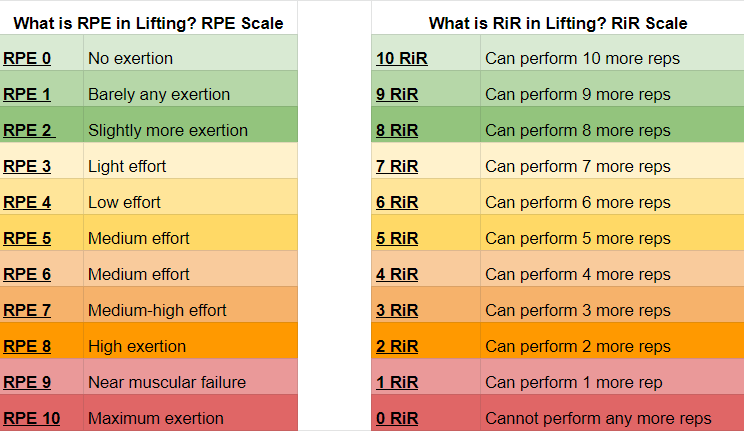
RPE in lifting, or Rate of Perceived Exertion, is the inverse of Reps in Reserve (RIR). Simply put, if a lifter completes one rep, they have an RPE of 1, indicating they have not exerted themselves much, however they may still have 9 reps left in the tank before reaching training failure RPE, and therefore have an RIR of 9.
Periodization
Even though periodization has gained traction in the fitness world, it is a concept that is not well known and/or simply not put into practice by many lifters. The daily undulating periodization is at its core the process of manipulating training variables daily that will lead to stimulating muscle growth and gains.
These variables are mainly the training intensity (measured by RPE) and training volume which is the number of sets by the number of reps by the load (weight).
Taking advantage of periodization to supercharge your gains also helps prevent training plateaus from creeping on lifters. Training plateaus happens when lifters are no longer making real concrete gains when doing the same exercise routine which results in the body adapting and becoming efficient.
This leads to burning less calories and growing less muscle.
Therefore, lifters should always alter training variables, use different variations of these exercises and strategies to ensure that the path to gains is always increasing and not stagnating.
Proper Diet & Increase Protein Intake
When lifters are engaged in strength training, they both deplete their resources and cause muscle damage. Lifting weights requires calories and energy to be able to get through a strength training program.
A push day calls for the engagement of 3 muscle groups, this requires a great deal of energy and in addition, the increased muscle mass needs more energy to be maintained (this is why weightlifting is a good way to lose weight). Lifters should therefore increase their calorie intake by 350-450 kcal daily to effectively build muscle.26
Muscle that breaks down during strength training needs to be repaired, made stronger and bigger to adapt to the load levels placed on it. This will require adequate amounts of protein—protein contains amino acids such as leucine, dileucine, isoleucine, valine and branded amino acids (BCAA’s) required for this recovery.27
Therefore, to sustain this recovery, lifters will need to consume 1.2-2 grams of protein daily per kilogram of bodyweight.28 For example, an individual weighing 150 lbs. should consume 136 grams of lean protein daily from high quality sources such as chicken breast, fish and eggs.
Getting Enough Sleep
Getting enough sleep is important for the recovery process. The PPL routine, if followed correctly, fortunately allows for enough rest between workouts, but lifters still need to get sufficient sleep and, depending on genetics, at least 7 hours of continuous sleep.
Getting sufficient sleep is also crucial to ensure muscle strength remains at peak levels to safeguard and ensure efficient workouts.29
The push day workout regimen which is part of an overall PPL program is an effective and efficient way to target the upper body contributing to a strong and muscular physique—adopt these 7 exercise routines that have been ranked from worst to best according to studies for a best day upper body strength workout that is sure to give solid results.
Frequently Asked Questions
How Many Exercises Should Someone Do on a Push Day?
Typically, a push day workout will consist of 6-8 different exercises which comes down to approximately 2 exercises per muscle group—chest, shoulders and triceps. Lifters should strive to complete each exercise in under 2 minutes and then take a 2 minute break between exercises.
What Are the Push Day Exercises for Beginners?
There are a number of push day exercises that are available for beginners and are relatively easy to learn; these include:
- The barbell and dumbbell bench press
- Pushups
- Overhead shoulder press
- Dumbbell hex press
- Skull crushers
- Dumbbell overhead triceps extension
- Guillotine press
- Dumbbell lateral raise
What Push Exercises Cause the Most Muscle Growth?
The best push workouts to build thick muscle mass are the staple compound movements that have been tried and tested by bodybuilders; they include:
- Barbell bench press
- Incline barbell bench press
- Standing barbell overhead press
- Dumbbell side lateral raise
- Incline Dumbbell bench press
- Arnold dumbbell press
- Close grip bench press
- Skull crushers
- Weighted Dips
Is 4 Exercises Sufficient for a Push Day?
For beginners, 4 exercises is sufficient for a push day since this is targeting 1-2 exercises per muscle group. However, advanced lifters who may be looking for more volume can do between 6-8 exercises on a push day which will mean each muscle group is receiving a minimum of 2 exercises.
What Supplements Can Be Taken On Push Day?
There are a number of supplements that lifters can take to enhance their workouts and give them the energy to power through their exercises—these include: creatine, caffeine, beta-alanine and whey protein. Creatine naturally occurs in the body and helps supply energy to the cells and is found in meat and fish.
It helps allow lifters to have short bursts of highly intensive workouts. Whey protein is a popular supplement that is distilled from milk and can provide vital amino acids that the body can use to repair tissue and build muscle.
References
1xalanx. Canva. Accessed 19 May 2023. <https://www.canva.com/photos/MADBbSf8BwQ-chest-workout-on-bench-press/>
2Ibrakovic. Canva. Accessed 18 May 2023. <https://www.canva.com/photos/MADB6igzWe0-chest-workout-on-bench-press/>
3Grant W. Ralston, L. K. (2018, August 3). Weekly Training Frequency Effects on Strength Gain: A Meta-Analysis. Retrieved 2023, from <https://www.ncbi.nlm.nih.gov/pmc/articles/PMC6081873>
4Solan, M. (2019, February 18). The rise of push-ups: A classic exercise that can help you get stronger. Retrieved 2023, from <https://www.health.harvard.edu/blog/rise-push-ups-classic-exercise-can-motivate-get-stronger-2019021810165>
5Varnitsin, Artem. Canva. Accessed 18 May 2023. <https://www.canva.com/photos/MAEmMdDFRSg-woman-doing-pushups/>
6Sumiaki Maeo, Y. W. (2022, August 11). Triceps brachii hypertrophy is substantially greater after elbow extension training performed in the overhead versus neutral arm position. Retrieved 2023, from <https://pubmed.ncbi.nlm.nih.gov/35819335/>
7Giuseppe Coratella, G. T. (2020, August 19). An Electromyographic Analysis of Lateral Raise Variations and Frontal Raise in Competitive Bodybuilders. Retrieved 2023, from <https://www.ncbi.nlm.nih.gov/pmc/articles/PMC7503819/>
8madproduction. Canva. Accessed 19 May 2023. <https://www.canva.com/photos/MAFLAjgxMNM-big-muscular-male-bodybuilder-working-out-with-dumbbells-doing-lateral-raise-exercise-at-gym/>
9Robert G. Lockie, S. J.-B. (2017, June 24). An Investigation of the Mechanics and Sticking Region of a One-Repetition Maximum Close-Grip Bench Press versus the Traditional Bench Press. Retrieved 2023, from <https://www.ncbi.nlm.nih.gov/pmc/articles/PMC5968970/>
10Barnett, C. K. (1995). Effects of variations of the bench press exercise on the EMG activity of five shoulder muscles. Retrieved 2023, from <https://espace.library.uq.edu.au/view/UQ:714265>
11Robert G. Lockie, S. J. (2018, September 15). Loading Range for the Development of Peak Power in the Close-Grip Bench Press versus the Traditional Bench Press. Retrieved 2023, from <https://www.ncbi.nlm.nih.gov/pmc/articles/PMC6162370/>
12LightFieldStudios. Canva. Accessed 19 May 2023. <https://www.canva.com/photos/MADCe2KrEVQ-handsome-sportsman-exercising-on-bench-press-in-gym/>
13Giuseppe Coratella, G. T. (2022, July). Front vs Back and Barbell vs Machine Overhead Press: An Electromyographic Analysis and Implications For Resistance Training. Retrieved 2023, from <https://pubmed.ncbi.nlm.nih.gov/35936912/>
14elenavagengeim. Canva. Accessed 19 May 2023. <https://www.canva.com/photos/MADHwo9FKcU-man-pushing-up-barbell/>
15Andrea Melani, G. G. (2019, October 17). Muscle Activation in Traditional and Experimental Barbell Bench Press Exercise: A Potential New Tool for Fitness Maintenance. Retrieved 2023, from <https://www.ncbi.nlm.nih.gov/pmc/articles/PMC6835758/>
16stockfour. Canva. Accessed 19 May 2023. <https://www.canva.com/photos/MADmd-HvvLQ-man-working-on-bench-press-push-with-barbell/>
17Déborah de Araújo Farias, J. M. (2017, July). Maximal Strength Performance and Muscle Activation for the Bench Press and Triceps Extension Exercises Adopting Dumbbell, Barbell, and Machine Modalities Over Multiple Sets. Retrieved 2023, from <https://pubmed.ncbi.nlm.nih.gov/27669189/>
18starush. Canva. Accessed 19 May 2023. <https://www.canva.com/photos/MADA0TIayj4-young-man-doing-dumbbell-incline-bench-press-workout-in-gym/>
19Leslie H. Willis, C. A. (2012, September 27). Effects of aerobic and/or resistance training on body mass and fat mass in overweight or obese adults. Retrieved 2023, from <https://www.ncbi.nlm.nih.gov/pmc/articles/PMC3544497/>
20Brad J. Schoenfeld, J. G. (2021, February 22). Loading Recommendations for Muscle Strength, Hypertrophy, and Local Endurance: A Re-Examination of the Repetition Continuum. Retrieved 2023, from <https://www.ncbi.nlm.nih.gov/pmc/articles/PMC7927075/>
21mihailomilovanovic. Canva. Accessed 19 May 2023. <https://www.canva.com/photos/MAED-WH2_LY-shoulder-exercise-dumbbell-lateral-raise-/>
22Joaquin Calatayud, J. V. (2016, March 1). Importance of mind-muscle connection during progressive resistance training. Retrieved 2023, from <https://pubmed.ncbi.nlm.nih.gov/26700744/>
23Brad J Schoenfeld, J. G. (2020, January 21). Effects of range of motion on muscle development during resistance training interventions: A systematic review. Retrieved 2023, from <https://www.ncbi.nlm.nih.gov/pmc/articles/PMC6977096/>
24Michal Krzysztofik, M. W. (2019, December 4). Maximizing Muscle Hypertrophy: A Systematic Review of Advanced Resistance Training Techniques and Methods. Retrieved 2023, from <https://www.ncbi.nlm.nih.gov/pmc/articles/PMC6950543/>
25Prevention, C. f. (2022, June 3). Perceived Exertion (Borg Rating of Perceived Exertion Scale). Retrieved 2023, from <https://www.cdc.gov/physicalactivity/basics/measuring/exertion.htm>
26Gary John Slater, B. P. (2019, August 20). Is an Energy Surplus Required to Maximize Skeletal Muscle Hypertrophy Associated With Resistance Training. Retrieved 2023, from <https://www.ncbi.nlm.nih.gov/pmc/articles/PMC6710320/>
27YATES, D. (2021, August 9). Study identifies molecule that stimulates muscle-building. Retrieved 2023, from <https://news.illinois.edu/view/6367/738187139>
28Becker, T. (2017, February 14). Protein intake for athletes. Retrieved 2023, from <https://www.canr.msu.edu/news/protein_intake_for_athletes>
29Olivia E Knowles, E. J. (2018, September). Inadequate sleep and muscle strength: Implications for resistance training. Retrieved 2023, from <https://pubmed.ncbi.nlm.nih.gov/29422383/>